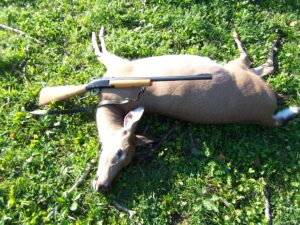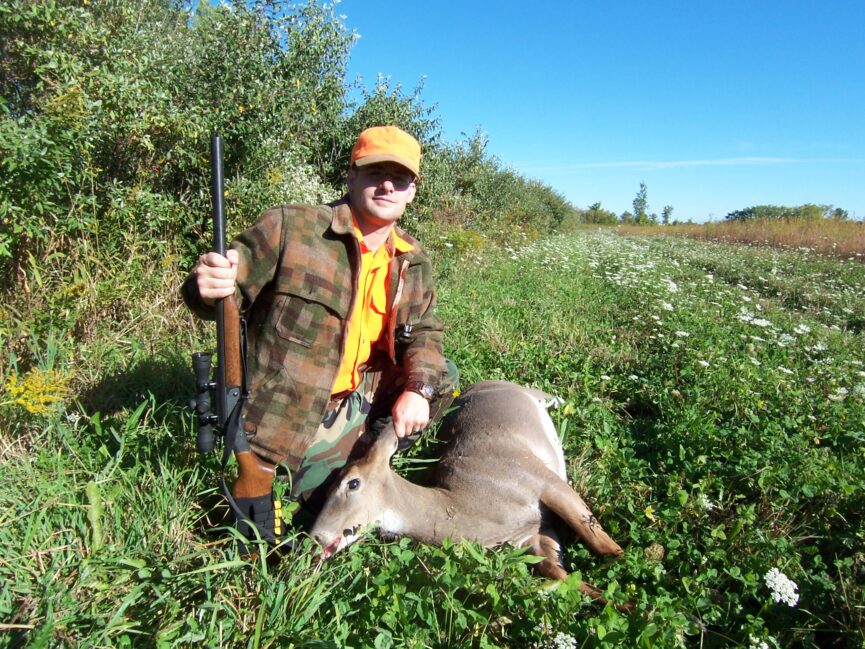One of the most daunting tasks for the Michigan Department of Natural Resources, is to get deer hunters to harvest a doe and when you check out the data of the overall annual deer harvest, antlered deer always outnumber antlerless deer. It is readily apparent that decades of a hunting tradition passed down through generations of Michigan deer hunters, that a female deer is the “Sacred Doe” of the forest, and making killing a doe in the past a literal taboo in the deer woods.
This deeply seated attitude relates to Michigan creating the “Bucks Only” law in 1921. In the early 20th Century, it was readily apparent that the whitetail deer herd in Michigan was quickly dwindling. There were efforts made in the early 1900’s to put a bag limit on the number of deer being taken, which previously had been quite liberal, but until 1921, the general attitude of deer hunters was “brown its down”, and shooting any deer was never looked down upon.

A clean kill on a harvested whitetail deer compliments of the author’s farm
The whitetail deer is quite resilient, not to mention adaptable, and by the late 1930’s, state conservation officials realized the “Bucks Only” law was working quite effectively, and it was readily apparent that a number of antlerless deer, preferably does, needed to be harvested in order to keep deer numbers in check with the available habitat. However, by this time, the “Sacred Doe” concept had already set deep roots with generations of Michigan deer hunters, an attitude which remains to this day. The issuing of antlerless deer licenses over the years was usually met with a lot of opposition.
I will never forget when the DNR decided to issue antlerless deer licenses for the Thumb area in 1970, which literally stirred the pot amongst the local deer hunters. The various sportsmen’s clubs encouraged everyone to apply for an antlerless permit, with the intent of destroying any that would be received in order to prevent them from being used. There would then be some ritualized “doe tag” burning parties.
As a recipient of one of those 1970 antlerless tags, I was happy to have it. I also didn’t agree with the obvious hysteria taking place with a majority of local deer hunters, and I looked upon that doe tag as an obvious bonus. And yep, folks, I tagged a plump, farm-fed doe which was delicious! I have been targeting does ever since, and my three sons (and now grandchildren) grew up doing the same. The first deer each bagged was a doe which makes the best venison. My family eats a lot of venison each year, making does being a prime target.
I truly appreciate both the early and late antlerless deer seasons offered now in Michigan, along with ample “doe tags”, which allows stocking up the family larder. I’ve frequently heard the complaint from some deer hunters that Michigan today, has too many back to back deer seasons, which doesn’t allow whitetails a chance to calm down, and thus be easier to hunt. Well, folks, whitetails, being prey animals, are wary and wily critters all the time. Hunting pressure can put deer on more of an edge, as should be expected. This becomes apparent when November 15th rolls around with a record number of deer hunters hitting the woods at the same time. This is when I’ve learned to hunt harder and smarter, and employ different hunting techniques, instead of just sitting static in one spot and hoping for the best. I appreciate and enjoy all the deer seasons offered in Michigan today.
I can remember the first early antlerless deer season which occurred in mid-September, 2008, when I was an avid participant, and have enjoyed being one ever since. I thoroughly appreciate the mild weather and the unique challenge of what I call “trophy doe hunting”, because bagging a mature doe isn’t always a slam-dunk affair. A mature doe has had a pretty much fulltime job looking out for her offspring, and is typically an ever watchful and suspicious sort. I know when I’ve tried to stalk into range of a buck that I have spotted during the rut (an “active”, non-static hunting technique I much enjoy), if a doe is with him, the challenge of closing-in increases exponentially.
Trophy doe hunting requires being able to properly know the physical characteristics of a mature female whitetail. A key indicator is the long nosed, “coke bottle” shape of the head, with ears which appear shorter in comparison to the size of the head. A young antlerless deer features a shorter nose and ears which poke right up creating a “Mickey Mouse” effect. A “Big Doe” contest I helped create to encourage harvesting antlerless deer, didn’t go by weight, but instead went by the measured distance from the tear duct to the tip of the nose. Being individuals, weight can really vary with does, despite their age, but the “nose knows”. The winning doe in that contest wasn’t the biggest physically but offered the longest snout. She was DNR-aged at 8-plus years due to very worn teeth, and had been lactating, which states that old does can keep producing more deer. Yep, folks, that was a true trophy!
Another good way to identify a doe, is when fawns are present, and a true comparison can be made. Those opposed to antlerless deer seasons claim that too many “button-bucks” are being eliminated, thus not allowing for more bucks in the future. Yep, some button-bucks do bite the dust, but statistics I’ve reviewed show it isn’t as detrimental as the rumor mill claims. On top of that, if a miscalculation occurs, in which harvesting a button-buck isn’t illegal during an antlerless season, there is some very tender and succulent venison to savor. For comparison, popular offerings on restaurant menus are lamb and veal, which nobody seems to complain about.
This year (like last year) I can purchase up to 20 ($!0) antlerless deer tags through the Deer Management Assistance Program (DMAP) to use during the regular deer hunting seasons on my farm. Deer numbers in my neck of the woods, as well as in much of the Lower Peninsula, have reached epidemic proportions, featuring record deer damage. Vehicle/deer collisions have been at an all-time high during the past three years. Hunting is a very necessary and important tool regarding proper deer management and Michigan deer hunters need to realize the importance of playing a key role in resolving the issue. The “Sacred Doe” concept is no more.
Besides the family larder, I’ve had requests from some folks for a doe to process into fine venison, and I plan on donating the rest to Feeding the Hungry programs certain local meat processors are involved with.
Yep, folks, I take my part in playing the proper deer management role very seriously, not to mention I truly enjoy the challenging outdoor pastime of trophy doe hunting.
- Fickle weather during December deer hunting adventures - December 3, 2025
- Michigan’s most popular opening day – November 15th - November 23, 2025
- A missing dog found while anticipating opening day - November 23, 2025

